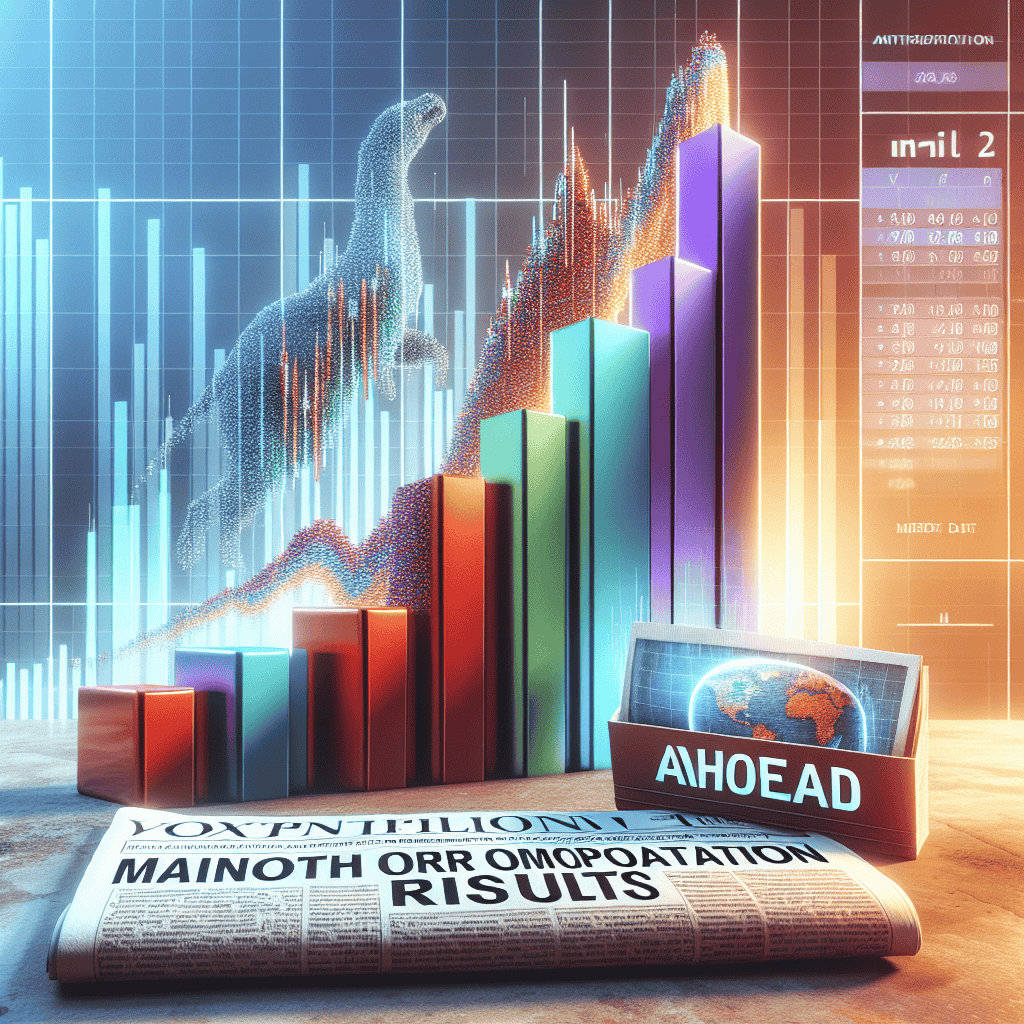“Anticipate the Surge: Navigating Megacap Earnings and Election Waves”
Introduction
Futures markets are showing signs of optimism as investors brace for a pivotal week marked by the release of earnings reports from major technology companies and the upcoming U.S. elections. The anticipation surrounding these events is driving market sentiment, with traders closely monitoring how the outcomes could influence economic policies and corporate performance. The earnings reports from megacap companies, which include industry giants with substantial market capitalizations, are particularly significant as they often set the tone for the broader market. Meanwhile, the U.S. elections add another layer of complexity, with potential implications for fiscal policy, regulatory changes, and international relations. As these developments unfold, market participants are poised to adjust their strategies in response to the evolving landscape.
Impact Of Megacap Earnings On Market Trends
As investors keenly anticipate the release of megacap earnings, the financial markets are poised for significant movements. These earnings reports, which come from some of the largest and most influential companies in the world, have the potential to sway market trends considerably. The anticipation surrounding these reports is palpable, as they not only reflect the health of individual companies but also serve as a barometer for broader economic conditions. Consequently, futures have been on the rise, indicating investor optimism and the expectation of positive earnings results.
The impact of megacap earnings on market trends cannot be overstated. Companies such as Apple, Amazon, Microsoft, and Alphabet hold substantial weight in major indices like the S&P 500 and the Nasdaq Composite. As a result, their financial performance can significantly influence the direction of these indices. When these companies report strong earnings, it often leads to a rally in the stock market, as investors gain confidence in the economic outlook. Conversely, disappointing earnings can trigger a sell-off, as concerns about growth prospects and profitability come to the fore.
In addition to their direct impact on stock prices, megacap earnings also provide insights into consumer behavior, technological advancements, and global supply chain dynamics. For instance, Apple’s earnings can shed light on consumer demand for technology products, while Amazon’s results may offer clues about e-commerce trends and consumer spending patterns. Similarly, Microsoft’s performance can indicate the state of enterprise software demand, and Alphabet’s earnings might reveal shifts in digital advertising. These insights are invaluable for investors seeking to understand the broader economic landscape and make informed decisions.
As the earnings season unfolds, it coincides with another significant event: the upcoming US election. The intersection of these two events adds an additional layer of complexity to market dynamics. Historically, elections have been periods of heightened volatility, as investors grapple with the potential implications of policy changes and shifts in political power. The outcome of the election could influence fiscal policy, regulatory frameworks, and international trade relations, all of which have direct implications for corporate earnings and market trends.
In this context, the rise in futures ahead of megacap earnings and the US election suggests a cautious optimism among investors. While there is hope for robust earnings reports, there is also an awareness of the uncertainties that the election may bring. Investors are likely positioning themselves to capitalize on potential gains while remaining vigilant to the risks that could emerge from the political arena.
Moreover, the interplay between megacap earnings and the election underscores the importance of diversification and risk management in investment strategies. As market conditions evolve, investors must be prepared to adjust their portfolios in response to new information and changing circumstances. This may involve reallocating assets, hedging against potential downturns, or seeking opportunities in sectors that are less exposed to political and economic uncertainties.
In conclusion, the anticipation of megacap earnings and the upcoming US election are pivotal factors shaping current market trends. As investors navigate this complex landscape, they must balance optimism with caution, recognizing the potential for both opportunities and challenges. The insights gleaned from earnings reports and the election outcome will undoubtedly play a crucial role in guiding investment decisions and shaping the trajectory of financial markets in the months to come.
How US Elections Influence Futures Markets
The interplay between U.S. elections and futures markets is a complex yet fascinating dynamic that captures the attention of investors worldwide. As futures rise ahead of megacap earnings and the U.S. election, understanding the underlying factors that drive this relationship becomes crucial for market participants. Futures markets, which allow investors to speculate on the future price of assets, are inherently sensitive to political events, given their potential to influence economic policies and market conditions.
Historically, U.S. elections have been pivotal in shaping market sentiment, as they often herald shifts in fiscal and monetary policies. The anticipation of policy changes can lead to increased volatility in futures markets, as investors adjust their positions in response to potential outcomes. For instance, a presidential candidate’s stance on taxation, regulation, and government spending can significantly impact sectors such as healthcare, energy, and technology, thereby influencing the corresponding futures contracts.
Moreover, the uncertainty surrounding election outcomes tends to heighten market volatility. Investors, wary of the potential for unexpected results, often hedge their portfolios by trading futures contracts. This hedging activity can lead to fluctuations in futures prices, as market participants seek to mitigate risk. The period leading up to an election is typically characterized by increased trading volumes, as investors position themselves for various scenarios.
In addition to domestic policies, U.S. elections can also affect international relations, which in turn influence global markets. Futures markets, being global in nature, are sensitive to changes in trade policies and diplomatic relations that may arise from a new administration. For example, a shift towards protectionist trade policies could impact commodity futures, as tariffs and trade barriers alter supply and demand dynamics.
Furthermore, the role of megacap companies in the economy cannot be understated. These large-capitalization firms, often leaders in their respective industries, have a significant impact on market indices and, by extension, futures markets. As these companies prepare to release their earnings reports, investors closely monitor their performance and guidance, as these factors can provide insights into broader economic trends. The intersection of megacap earnings and election outcomes creates a unique environment where futures markets are influenced by both corporate performance and political developments.
It is also important to consider the psychological aspect of market behavior during election periods. Investor sentiment, driven by media coverage and public opinion polls, can lead to speculative trading in futures markets. The perception of a candidate’s likelihood to win can sway market expectations, prompting investors to adjust their strategies accordingly. This sentiment-driven trading can amplify market movements, contributing to the volatility observed during election cycles.
In conclusion, the influence of U.S. elections on futures markets is multifaceted, encompassing policy expectations, market sentiment, and global economic implications. As futures rise ahead of megacap earnings and the U.S. election, investors must navigate a landscape shaped by both political and corporate factors. By understanding the intricate relationship between elections and futures markets, investors can better position themselves to capitalize on opportunities and manage risks in an ever-evolving financial environment.
Analyzing The Correlation Between Earnings Reports And Stock Futures
As investors keenly anticipate the release of earnings reports from megacap companies, the stock futures market often provides a glimpse into potential market movements. The correlation between earnings reports and stock futures is a subject of considerable interest, particularly as these reports can significantly influence investor sentiment and market dynamics. Understanding this relationship is crucial for investors seeking to navigate the complexities of the financial markets, especially in the context of an impending U.S. election, which adds another layer of uncertainty and potential volatility.
Earnings reports serve as a critical barometer of a company’s financial health, offering insights into its profitability, revenue growth, and overall business performance. When megacap companies, which are typically industry leaders with substantial market capitalizations, release their earnings, the impact on stock futures can be pronounced. Positive earnings surprises often lead to a rise in stock futures, as investors anticipate higher future valuations and increased investor confidence. Conversely, disappointing earnings can result in a decline in futures, reflecting concerns over a company’s growth prospects and potential market instability.
The anticipation surrounding these earnings reports is further heightened by the timing of the U.S. election. Historically, elections have been periods of heightened market volatility, as investors grapple with the potential implications of policy changes and shifts in economic priorities. The intersection of earnings season and the election cycle creates a unique environment where stock futures are influenced by both corporate performance and political developments. This dual influence can lead to increased market sensitivity, as investors weigh the potential outcomes of the election against the backdrop of corporate earnings.
Moreover, the correlation between earnings reports and stock futures is not solely a function of the numbers themselves but also the narratives that accompany them. Forward guidance provided by company executives during earnings calls can significantly sway investor sentiment. For instance, a company that reports strong earnings but issues cautious guidance due to geopolitical uncertainties or supply chain disruptions may see its stock futures react negatively. This highlights the importance of qualitative factors in shaping market expectations and underscores the complexity of predicting market movements based solely on quantitative data.
In addition to company-specific factors, macroeconomic conditions play a pivotal role in shaping the relationship between earnings reports and stock futures. Interest rates, inflation, and global economic trends can all influence how investors interpret earnings data. For example, in a low-interest-rate environment, investors may be more forgiving of lower earnings, anticipating that cheap borrowing costs will support future growth. Conversely, in a high-inflation scenario, even robust earnings may not be enough to assuage investor concerns about eroding purchasing power and profit margins.
As investors analyze the correlation between earnings reports and stock futures, it is essential to adopt a holistic approach that considers both microeconomic and macroeconomic factors. By doing so, they can better understand the nuances of market reactions and make more informed investment decisions. As the earnings season unfolds and the U.S. election approaches, the interplay between these elements will undoubtedly shape the trajectory of stock futures, offering both challenges and opportunities for market participants. In this dynamic environment, staying informed and adaptable will be key to navigating the complexities of the financial markets.
Strategies For Investors During Election And Earnings Season

As investors navigate the complex landscape of financial markets, the convergence of megacap earnings reports and the U.S. election cycle presents both opportunities and challenges. This period is often characterized by heightened volatility and uncertainty, necessitating strategic approaches to safeguard investments while capitalizing on potential gains. Understanding the dynamics at play during this time is crucial for investors aiming to make informed decisions.
Firstly, it is essential to recognize the impact of megacap earnings on market sentiment. Companies with large market capitalizations, such as those in the technology sector, often set the tone for broader market movements. Their earnings reports can significantly influence investor confidence, as these companies are typically seen as bellwethers for economic health. Consequently, investors should closely monitor these reports, paying attention to not only the earnings figures but also the forward guidance provided by company executives. This information can offer valuable insights into future market trends and help investors adjust their portfolios accordingly.
Simultaneously, the U.S. election cycle introduces another layer of complexity. Elections can lead to policy shifts that affect various sectors differently, depending on the political landscape. For instance, changes in tax policies, regulatory frameworks, or government spending priorities can have profound implications for industries such as healthcare, energy, and finance. Therefore, investors should consider the potential outcomes of the election and how these might impact their investments. Diversifying across sectors that may benefit from different electoral outcomes can be a prudent strategy to mitigate risks associated with political uncertainty.
Moreover, during this period, it is advisable for investors to maintain a long-term perspective. While short-term market fluctuations can be unsettling, history has shown that markets tend to recover over time. By focusing on long-term goals and maintaining a diversified portfolio, investors can better withstand the temporary volatility that often accompanies earnings seasons and elections. This approach not only helps in managing risk but also positions investors to take advantage of potential market rebounds.
In addition to diversification, employing hedging strategies can be beneficial. Options and futures contracts, for example, can provide a level of protection against adverse market movements. These financial instruments allow investors to hedge their positions, thereby reducing potential losses while still participating in market gains. However, it is important for investors to fully understand these instruments and consider their risk tolerance before incorporating them into their strategies.
Furthermore, staying informed is paramount during this period. Investors should keep abreast of economic indicators, geopolitical developments, and market analyses from reputable sources. This information can aid in making timely and informed decisions, allowing investors to adjust their strategies as new data emerges. Engaging with financial advisors or utilizing investment platforms that offer real-time insights can also enhance decision-making processes.
In conclusion, the intersection of megacap earnings and the U.S. election cycle presents a unique set of challenges and opportunities for investors. By closely monitoring earnings reports, considering the implications of electoral outcomes, maintaining a long-term perspective, diversifying portfolios, and employing hedging strategies, investors can navigate this period with greater confidence. Ultimately, staying informed and adaptable will be key to successfully managing investments during this dynamic time.
The Role Of Megacap Companies In Economic Forecasting
In the intricate world of economic forecasting, megacap companies play a pivotal role, serving as both indicators and influencers of broader market trends. As futures rise ahead of significant earnings reports from these corporate giants and the impending U.S. election, it becomes increasingly important to understand how these entities shape economic expectations and investor sentiment. Megacap companies, characterized by their substantial market capitalizations, often exceeding hundreds of billions of dollars, include industry leaders such as Apple, Microsoft, Amazon, and Alphabet. These companies not only dominate their respective sectors but also wield considerable influence over the stock market and, by extension, the economy.
The performance of megacap companies is closely monitored by investors and analysts alike, as their earnings reports can provide valuable insights into the health of the economy. For instance, robust earnings from these companies may signal strong consumer demand and technological innovation, suggesting a thriving economic environment. Conversely, disappointing results could indicate potential economic slowdowns or challenges within specific industries. As such, the anticipation of earnings reports from these corporate behemoths often leads to fluctuations in futures markets, reflecting the market’s expectations and reactions to potential outcomes.
Moreover, the influence of megacap companies extends beyond their financial performance. Their strategic decisions, such as investments in new technologies or expansions into emerging markets, can set industry trends and drive economic growth. For example, a decision by a leading technology company to invest heavily in artificial intelligence could spur a wave of innovation and investment across the tech sector, ultimately contributing to economic expansion. This interconnectedness underscores the importance of megacap companies in shaping economic forecasts and guiding investor strategies.
In addition to their direct impact on the economy, megacap companies also play a crucial role in shaping policy discussions and regulatory frameworks. Given their size and influence, these companies often find themselves at the center of debates on issues such as antitrust regulations, data privacy, and corporate taxation. The outcomes of these discussions can have significant implications for the broader economy, influencing everything from consumer protection laws to international trade agreements. As such, the actions and strategies of megacap companies are closely scrutinized by policymakers and regulators, further highlighting their role in economic forecasting.
As the U.S. election approaches, the interplay between megacap companies and economic forecasting becomes even more pronounced. Elections can introduce elements of uncertainty into the market, as changes in administration or policy priorities can impact economic conditions. In this context, the performance and strategic direction of megacap companies can serve as a stabilizing force, providing continuity and confidence to investors amid potential political shifts. Furthermore, these companies often engage in political advocacy, seeking to influence policy outcomes that align with their business interests, thereby shaping the economic landscape in which they operate.
In conclusion, megacap companies are integral to economic forecasting, serving as both barometers and drivers of market trends. Their earnings reports, strategic decisions, and interactions with policymakers provide critical insights into the state of the economy and the potential direction of future growth. As futures rise in anticipation of their earnings and the U.S. election, the role of these corporate giants in shaping economic expectations remains as significant as ever, underscoring their enduring influence on the global economic stage.
Navigating Market Volatility Amidst Political And Economic Events
As investors brace for a week of significant developments, futures are on the rise, driven by anticipation surrounding megacap earnings and the upcoming U.S. election. This confluence of economic and political events is poised to inject a fresh wave of volatility into the markets, challenging investors to navigate an increasingly complex landscape. The interplay between corporate performance and political outcomes is expected to shape market sentiment, with each factor exerting its own influence on investor behavior.
To begin with, the earnings reports from megacap companies, which include some of the largest and most influential corporations in the world, are eagerly awaited by market participants. These companies, often leaders in technology and consumer sectors, have a substantial impact on market indices due to their significant market capitalizations. As such, their financial performance can set the tone for broader market trends. Investors are keenly focused on these earnings reports, as they provide critical insights into the health of key sectors and the overall economy. Positive earnings surprises could bolster investor confidence, potentially driving markets higher, while disappointing results might trigger a wave of risk aversion.
Simultaneously, the U.S. election looms large on the horizon, adding another layer of complexity to the market environment. Political outcomes have historically influenced market dynamics, as changes in administration can lead to shifts in fiscal and regulatory policies. Investors are particularly attentive to potential policy changes that could impact taxation, trade, and industry regulations. The uncertainty surrounding the election results can lead to heightened market volatility, as investors attempt to position themselves for various scenarios. In this context, futures markets serve as a barometer of investor sentiment, reflecting expectations and hedging strategies in response to anticipated political developments.
Moreover, the intersection of these economic and political events underscores the importance of strategic risk management. Investors are increasingly seeking ways to mitigate potential downside risks while capitalizing on opportunities that may arise. Diversification remains a key strategy, allowing investors to spread risk across different asset classes and geographies. Additionally, the use of derivatives and other hedging instruments can provide a buffer against adverse market movements. By employing a disciplined approach to risk management, investors can better navigate the uncertainties inherent in the current environment.
Furthermore, the role of central banks cannot be overlooked in this context. Monetary policy decisions, particularly those related to interest rates and quantitative easing, continue to play a pivotal role in shaping market conditions. Central banks are closely monitoring economic indicators and stand ready to adjust policies as needed to support economic stability. Their actions can influence investor sentiment and market liquidity, further contributing to the complexity of the investment landscape.
In conclusion, as futures rise ahead of megacap earnings and the U.S. election, investors are faced with the challenge of navigating market volatility amidst a backdrop of significant economic and political events. The interplay between corporate performance, political outcomes, and central bank policies will be crucial in determining market trajectories. By maintaining a focus on strategic risk management and staying informed about key developments, investors can position themselves to effectively manage the uncertainties and opportunities that lie ahead.
Future Market Predictions Post-Election And Earnings Announcements
As investors brace for a pivotal week, futures markets are showing signs of optimism, buoyed by the anticipation of earnings reports from megacap companies and the upcoming U.S. election. This confluence of events is poised to significantly influence market dynamics, as stakeholders seek to navigate the complexities of economic forecasts and corporate performance. The interplay between these factors is crucial, as it not only reflects the current economic climate but also sets the stage for future market trajectories.
The earnings season, particularly for megacap companies, serves as a barometer for the broader economy. These corporations, with their vast market capitalizations and global reach, often provide insights into consumer behavior, supply chain efficiencies, and technological advancements. As such, their financial health and strategic outlooks are closely scrutinized by analysts and investors alike. The anticipation surrounding these earnings announcements is palpable, as they are expected to shed light on how these giants are adapting to ongoing economic challenges, including inflationary pressures and geopolitical tensions.
Simultaneously, the U.S. election adds another layer of complexity to market predictions. Historically, elections have been pivotal in shaping economic policies and regulatory frameworks, which in turn affect market sentiment. The outcome of the election could lead to shifts in fiscal policies, trade agreements, and regulatory landscapes, all of which are critical factors for investors to consider. As the election approaches, market participants are keenly observing political developments, understanding that the results could either bolster or undermine investor confidence.
In this context, futures markets are often seen as a reflection of investor sentiment and expectations. The rise in futures ahead of these significant events suggests a cautiously optimistic outlook among investors. This optimism may be driven by the belief that megacap companies will report robust earnings, demonstrating resilience in the face of economic headwinds. Additionally, there is a sense that the election could bring about policy changes that might stimulate economic growth or provide clarity on regulatory issues that have been sources of uncertainty.
However, it is important to note that while futures markets can provide a glimpse into investor sentiment, they are not infallible predictors of market movements. The inherent volatility and unpredictability of both corporate earnings and political outcomes mean that markets could react in unexpected ways. Therefore, investors are advised to remain vigilant and consider a range of scenarios when making investment decisions.
Moreover, the interconnectedness of global markets means that developments in the U.S. can have far-reaching implications. As such, international investors are also closely monitoring these events, understanding that the ripple effects could impact global trade, currency valuations, and cross-border investments. This global perspective underscores the importance of a comprehensive approach to market analysis, one that takes into account both domestic and international factors.
In conclusion, as futures rise ahead of megacap earnings and the U.S. election, the financial landscape is poised for potential shifts. Investors are navigating a complex web of economic indicators, corporate performance metrics, and political developments. While the optimism reflected in futures markets is encouraging, it is tempered by the understanding that uncertainty remains a constant in the world of finance. As such, a balanced and informed approach will be essential for navigating the post-election and post-earnings market environment.
Q&A
1. **What are futures?**
Futures are financial contracts obligating the buyer to purchase, or the seller to sell, an asset at a predetermined future date and price.
2. **What are megacap companies?**
Megacap companies are firms with a market capitalization typically over $200 billion, often including major tech giants like Apple, Microsoft, and Amazon.
3. **Why do futures rise ahead of earnings reports?**
Futures may rise ahead of earnings reports due to investor optimism about strong financial performance, leading to anticipated stock price increases.
4. **How can US elections impact futures markets?**
US elections can impact futures markets by creating uncertainty or optimism about future economic policies, regulatory changes, and fiscal measures.
5. **What is the significance of earnings reports for investors?**
Earnings reports provide insights into a company’s financial health, profitability, and future prospects, influencing investment decisions and stock prices.
6. **How do investors typically react to megacap earnings announcements?**
Investors closely monitor megacap earnings announcements as they can significantly impact market sentiment and indices due to the large market influence of these companies.
7. **What strategies might traders use in anticipation of earnings and elections?**
Traders might use strategies such as options trading, hedging, or adjusting portfolio allocations to manage risk and capitalize on potential market movements.
Conclusion
The anticipation of megacap earnings and the upcoming U.S. election has led to a rise in futures, reflecting investor optimism and market volatility. As major technology companies prepare to release their financial results, market participants are closely watching for indicators of economic resilience and growth potential. Additionally, the political landscape and potential policy shifts resulting from the election are contributing to market dynamics. This environment underscores the importance of strategic positioning and risk management for investors navigating the current financial landscape.





